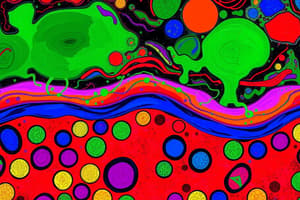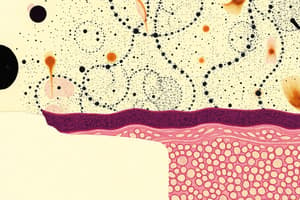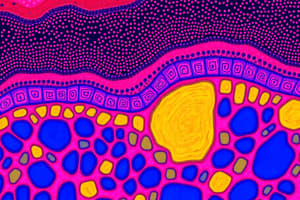Podcast
Questions and Answers
Which cell type is characteristic of relaxed transitional epithelium?
Which cell type is characteristic of relaxed transitional epithelium?
- Elongated, flattened cells
- Goblet cells
- Ciliated cells
- Dome-shaped umbrella cells (correct)
What is the primary function of the basement membrane?
What is the primary function of the basement membrane?
- To be a selective barrier for blood vessels
- To facilitate the diffusion of nutrients
- To provide structural support to muscles
- To be secreted by the epithelium and anchor to underlying tissues (correct)
Which stain is utilized to easily identify the basal lamina?
Which stain is utilized to easily identify the basal lamina?
- Periodic acid-Schiff (PAS) stain (correct)
- Hematoxylin and Eosin (H&E) stain
- Wright's stain
- Masson’s trichrome stain
In which location is the basal lamina typically observed as a prominent structure?
In which location is the basal lamina typically observed as a prominent structure?
How is the basal lamina arranged in the splenic venous sinuses?
How is the basal lamina arranged in the splenic venous sinuses?
What is a primary function of epithelial tissue?
What is a primary function of epithelial tissue?
Which type of epithelial cells are responsible for increasing the surface area?
Which type of epithelial cells are responsible for increasing the surface area?
What is the primary function of the basal lamina in epithelial tissue?
What is the primary function of the basal lamina in epithelial tissue?
Which cell junction type is primarily responsible for forming a water-tight seal between cells?
Which cell junction type is primarily responsible for forming a water-tight seal between cells?
What is the key role of the cytoskeleton in epithelial cells?
What is the key role of the cytoskeleton in epithelial cells?
Which of the following describes the primary difference between exocrine and endocrine glands?
Which of the following describes the primary difference between exocrine and endocrine glands?
What is the main distinction between mucous and serous glands?
What is the main distinction between mucous and serous glands?
What specific structural component is responsible for the ability of some epithelial cells, such as those in the respiratory tract, to sweep debris and fluid?
What specific structural component is responsible for the ability of some epithelial cells, such as those in the respiratory tract, to sweep debris and fluid?
Which of the following is NOT a primary means of classifying epithelial tissue?
Which of the following is NOT a primary means of classifying epithelial tissue?
Which type of epithelium is characterized by a single layer of flat, scale-like cells?
Which type of epithelium is characterized by a single layer of flat, scale-like cells?
What is the term for the type of simple squamous epithelium that lines blood vessels?
What is the term for the type of simple squamous epithelium that lines blood vessels?
Which of these is an example of a location where you would find simple cuboidal epithelium?
Which of these is an example of a location where you would find simple cuboidal epithelium?
Which of the following is NOT a specialization seen in some epithelial tissues?
Which of the following is NOT a specialization seen in some epithelial tissues?
The epithelium of the small intestine is primarily involved in:
The epithelium of the small intestine is primarily involved in:
What type of epithelium is found in the Fallopian tube and what is its primary function there?
What type of epithelium is found in the Fallopian tube and what is its primary function there?
Which of these organs does NOT contain a protective epithelium lining?
Which of these organs does NOT contain a protective epithelium lining?
Which type of epithelial tissue is found lining the small intestine?
Which type of epithelial tissue is found lining the small intestine?
The presence of cilia is a notable characteristic of the epithelial lining in which of these locations?
The presence of cilia is a notable characteristic of the epithelial lining in which of these locations?
Which of these locations contains stratified squamous keratinized epithelium?
Which of these locations contains stratified squamous keratinized epithelium?
Where would you most likely find a stratified cuboidal epithelium?
Where would you most likely find a stratified cuboidal epithelium?
Which of these epithelial types is characterized by having a single layer of cells that appear to be stratified due to the nuclei being at different levels?
Which of these epithelial types is characterized by having a single layer of cells that appear to be stratified due to the nuclei being at different levels?
What is the primary function of the non-keratinized stratified squamous epithelium in the esophagus?
What is the primary function of the non-keratinized stratified squamous epithelium in the esophagus?
Which epithelial type is located in the epididymis?
Which epithelial type is located in the epididymis?
Which of these options is not lined with a simple columnar epithelium?
Which of these options is not lined with a simple columnar epithelium?
Flashcards
Epithelial Tissue
Epithelial Tissue
A type of tissue that forms a continuous sheet of closely packed cells with little or no intercellular space, covering all free body surfaces and lining internal cavities and tubes.
Simple Squamous Epithelium Function
Simple Squamous Epithelium Function
Simple squamous epithelium allows for rapid diffusion and filtration due to its thinness and close proximity of cells.
Endothelium
Endothelium
A layer of epithelial cells that lines the inner surface of blood vessels and lymphatic vessels.
Mesothelium
Mesothelium
Signup and view all the flashcards
Microvilli
Microvilli
Signup and view all the flashcards
Gland
Gland
Signup and view all the flashcards
Exocrine Gland
Exocrine Gland
Signup and view all the flashcards
Endocrine Gland
Endocrine Gland
Signup and view all the flashcards
Simple Squamous Epithelium
Simple Squamous Epithelium
Signup and view all the flashcards
Simple Cuboidal Epithelium
Simple Cuboidal Epithelium
Signup and view all the flashcards
Simple Columnar Epithelium
Simple Columnar Epithelium
Signup and view all the flashcards
Stratified Squamous Epithelium
Stratified Squamous Epithelium
Signup and view all the flashcards
Stratified Cuboidal Epithelium
Stratified Cuboidal Epithelium
Signup and view all the flashcards
Stratified Columnar Epithelium
Stratified Columnar Epithelium
Signup and view all the flashcards
Pseudostratified Epithelium
Pseudostratified Epithelium
Signup and view all the flashcards
Transitional Epithelium
Transitional Epithelium
Signup and view all the flashcards
Transitional Epithelium: What is it?
Transitional Epithelium: What is it?
Signup and view all the flashcards
What is the Basal Lamina?
What is the Basal Lamina?
Signup and view all the flashcards
What does the PAS stain do?
What does the PAS stain do?
Signup and view all the flashcards
Where is the Basal Lamina prominent?
Where is the Basal Lamina prominent?
Signup and view all the flashcards
How does the Basal Lamina vary?
How does the Basal Lamina vary?
Signup and view all the flashcards
Study Notes
Epithelial Tissue Part 1
- Epithelial tissue is one of four basic tissues in the body
- The other three basic tissues are connective, nerve, and muscle tissue
- Epithelial tissue covers the external body surface and lines the internal body cavities and tubes
- Epithelial tissue is avascular; it obtains nutrients by diffusion from blood vessels in the underlying tissue
- Epithelial tissue is composed of cells closely attached by cell-to-cell junctions
Learning Objectives
- Differentiate between and compare the functions of 8 morphologically different types of epithelium
- Determine the general and specific characteristic features of the various epithelia of the body
- Differentiate between endothelium and mesothelium
- Understand the exception to simple squamous designation in lymph nodes and the spleen
- Identify how protective, secretory, excretory, lubricating, absorptive, and reproductive functions of epithelia contribute to individual health
- Identify and match locations of epithelia based on their specific functions
- Explain the functions and examples of the locations of apical, basal, and lateral surface modifications of epithelial cells
- Define microvilli, stereocilia, and cilia, and correlate their structure to function
- Identify the structure and functions of the basal and external laminae
- Name the different types of cell-to-cell and cell-to-matrix junctions and define their functions
- Identify the structural elements contributing to these junctions
- Define the elements of the cytoskeleton and correlate their distribution to their functions
- Define a gland, outline their morphological patterns, and state their general functions
- Classify specific glands in the body based on their morphological features
- List functional and morphological features of exocrine and endocrine glands, and cite specific examples
- Review functional and structural differences between mucous and serous glands
- Identify microscopic characteristics of mucous and serous glands
- Describe ultrastructural features of cells and other structures that make up the exocrine glands
- Differentiate between various modes of secretion of exocrine glands (e.g., merocrine, apocrine, holocrine)
- Histologically identify specific glands and match them to merocrine, apocrine, holocrine, endocrine, and exocrine classifications
- Relate ultrastructural appearance of a gland to its functions
- Identify serous and mucous membranes
Epithelial Tissue: Characteristics of Epithelial Cells
- Epithelial cells are arranged in sheets, one or multiple layers
- Sheets can be arranged as glands (secretory portions or parenchyma of glands)
- Attached by cell-to-cell junctions
- Exhibit three distinct surface domains (apical, lateral, and basal) with specific lipid and integral membrane protein properties identifiable by special techniques
Characteristics of Epithelial Cells (cont.)
- Basal surface of epithelial cells is attached to an underlying non-cellular basement membrane
- The basement membrane is a protein-polysaccharide structure visible with PAS stain
- In special situations, epithelial cells lack a free surface and are called epithelioids (e.g., islets of Langerhans, interstitial cells of Leydig)
Functions of Epithelium
- Epithelia have numerous functions, including physical protection, selective transport (diffusion, absorption, secretion), secretion, absorption, transportation, mechanical protection, and receptor function
- Examples of specialized epithelial functions include absorptive columnar epithelium in the intestines and secretory columnar epithelium in the stomach
Classification of Epithelium
- Classified by cell shape (squamous, cuboidal, columnar) and number of cell layers (simple, stratified)
- Additional specializations (cilia, keratin, goblet cells) also used for categorization
Epithelial Types:
- Simple squamous
- Simple cuboidal
- Simple columnar
- Stratified squamous
- Stratified cuboidal
- Stratified columnar
- Pseudostratified
- Transitional
Simple Squamous Epithelium
- It is one cell thick, with a shape where the width is greater than height
- Functions include diffusion and filtration
- Located in the walls of Bowman's capsule, respiratory spaces (alveoli), and lining blood/lymphatic vessels (endothelium), and body cavities (mesothelium)
Simple Cuboidal Epithelium
- One cell thick and cube-shaped
- Its function includes protection, absorption, and secretion
- It is found in glandular ducts, thyroid follicles, kidney tubules, and parts of the kidney's collecting ducts
Simple Columnar Epithelium
- This type is one cell thick and tall
- Functions include absorption and secretion. Types include ciliated and non-ciliated
- Ciliated varieties are found in the fallopian tubes and large bronchioles of the lungs. Those that are not ciliated (non-ciliated) types are found in the small intestine.
Stratified Squamous Epithelium
- Two or more cell layers
- Includes keratinized and non-keratinized subtypes
- The superficial layer composed of squamous cells
- Non-keratinized types line the oral cavity, pharynx, esophagus, and vagina
- Keratinized types are found in the epidermis of the skin
Stratified Cuboidal Epithelium
- Consists of more than one layer of cube-shaped epithelial cells
- It is found in the ducts of sweat glands and in larger ducts of exocrine glands
- Its function is barrier and protection.
Stratified Columnar Epithelium
- More than one layer of columnar cells, with columnar cells prominent in the uppermost layer
- It is located in the largest ducts of exocrine glands
- Functions as a barrier and conduit.
Pseudostratified Epithelium
- Gives a false appearance of layering due to varying cell heights, but it is actually simple
- It has various subtypes: non-ciliated, ciliated, and stereocilia (with stereocilia located in the reproductive organs)
- Common location is upper respiratory tract, seminal vesicles, and epididymis
Transitional Epithelium or Urothelium
- Specialized stratified epithelium; its function and cell shape and numbers of cell layers change depending on whether the bladder is full or empty
- It is found in the renal calyces, ureters, urinary bladder, and proximal urethra
Mucous Membranes
- Lines cavities that open to the exterior, such as the digestive, respiratory, and urogenital tracts
- Consist of epithelial tissue, basal lamina, and underlying connective tissue
- May have glands that secrete mucus
Serous Membranes
- Lines closed cavities in the body, such as the peritoneal and pleural cavities
- Consists of simple squamous epithelium (mesothelium), a basal lamina, and underlying connective tissue
- Do not contain glands
Basement Membrane
- Synthesized by epithelium; components are secreted and assembled extracellularly.
- Supports and compartmentalizes tissue via structural attachment to epithelium
- Involved in filtration, tissue scaffolding for regeneration, and separation of tissues
- Characterized by two basic layers, lamina densa, and lamina lucida (or rara)
Squamous Cell Carcinoma
- Maligned squamous cells arise due to abnormal squamous epithelium formation
- A diagnosis is facilitated by large amounts of keratin produced in characteristic swirls and nests
Studying That Suits You
Use AI to generate personalized quizzes and flashcards to suit your learning preferences.




